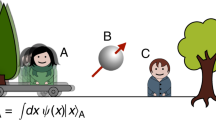Summary
The concepts of stationarity, homogeneity and isotropy are introduced in terms of the invariance of certain expectation values under time translations, under space translations and under space rotations respectively. Some consequences of homogeneity and isotropy on the forms and relations among second-order correlation tensors of the electromagnetic field are derived. It is shown that, if the second-order correlation tensors are invariant under space translations, they are also invariant under time translations. Further it is also shown that in such cases the trace of the electric correlation tensor is identical to the trace of the magnetic correlation tensor. General forms of the second-order electromagnetic correlation tensors are derived for fields which are both isotropic and homogeneous. Both quantum and classical descriptions of coherence are considered and the restrictions which stationarity, homogeneity or isotropy impose on the density operator in quantum description and on the probability distributions in classical description are deduced.
Riassunto
Si introducono i concetti di stazionarietà, omogeneità ed isotropia in base all’invarianza di alcuni valori di aspettazione per traslazioni temporali, per traslazioni spaziali e per rotazioni spaziali rispettivamente. Si deducono alcune conseguenze dell’omogeneità e dell’isotropia sulle forme e le relazioni tra i tensori di correlazione del secondo ordine del campo elettromagnetico. Si dimostra che, se i tensori di correlazione del secondo ordine sono invarianti rispetto alle traslazioni spaziali, essi sono anche invarianti rispetto alle traslazioni temporali. Si dimostra pure inoltre che in questi casi la traccia del tensore di correlazione elettrico è identica alla traccia del tensore di correlazione magnetico. Si deducono forme generali dei tensori di correlazione elettromagnetici di secondo ordine per campi che sono sia isotropici che omogenei. Si tien conto sia della descrizione quantistica che di quella classica della coerenza e si deducono le restrizioni che la stazionarietà, l’omogeneità o l’isotropia impongono all’operatore di densità nella descrizione quantistica e alla distribuzione probabilistica nella descrizione classica.
Реэюме
Вводятся понятия стационарности, однородности и иэотропии в терминах инвариантности некоторых ожидаемых величин относительно временных трансляций, пространственных трансляций и пространственных врашений, соответственно. Выводятся некоторые следствия однородности и иэотропии на формы и соотнощения между корреляционными тенэорами второго порядка для злектромагнитного поля. Покаэывается, что если корреляционные тенэоры второго порядка инвариантны относительно пространственных трансляций, то они также инвариантны относительно временных трансляций. Затем также покаэывается, что в таких случаях след злектрического тенэора корреляции является идентичным следу магнитного тенэора корреляции. Выводятся обшие формы злектромагнитных корреляции. Выводятся обшие формы злектромагнитных корреляционных тенэоров второго порядка для полей, которые являются и иэотропными и однородными. Рассматриваются и квантовое и классическое описания когерентности, и устанавливаются ограничения, которые накладывают стационарность, однородность или иэотропность на оператор плотности при квантовом описании и на распределения вероятностей при классическом описании.
Similar content being viewed by others
References
R. J. Glauber:Phys. Rev.,130, 2529 (1963).
Y. Kano:Ann. of Phys.,30, 127 (1964); see alsoL. Mandel:Phys. Lett.,10, 166 (1964).
See for exampleD. Middleton:An Introduction to Statistical Commutation Theory (New York, 1960), p. 36.
Strictly speaking, one should define the concept of homogeneity (and also that of isotropy) in terms of the invariance property of the average of an arbitrary function of field variables. However, in this paper we are only interested in the consequences of the invariance properties of the correlation tensors.
See for exampleK. Gottfried:Quantum Mechanics, vol.1:Fundamentals (New York, 1966), p. 409.
In this paper all the operators except vector operators (such as the linear-momentum operatorP and the angular-momentum operatorJ) are indicated by a caret.
While this paper was being written,J. H. Eberly andA. Kujawski (Phys. Lett.,24 A, 426 (1967)) have also defined the concept of homogeneity in terms of the relation (2.4).
C. L. Mehta andE. Wolf:Phys. Rev.,157, 1183 (1967).
Cf.E. C. G. Sudarshan: to be published in theIntern. Journ. Theoret. Phys. The operator √−▽2 is a nonlocal operator and is defined as follows. If one expresses the functionF(r) as a three-dimensional Fourier integralF(r)=∫ƒ(k) exp [i k·r]d3 k, then\(\sqrt { - V^2 } F(r) \equiv \int {k \cdot f(k) \cdot \exp [ik \cdot r} ]d^3 k.\).
C. L. Mehta andE. Wolf:Phys. Rev.,157, 1188 (1967).
See for example ref. (5), p. 412, 413 and 422.
C. L. Mehta andE. Wolf:Phys. Rev.,134, A 1149 (1964).
E. Wolf:Proceedings of the Symposium on Optical Masers (New York, 1963), p. 29; see alsoL. Mandel andE. Wolf:Rev. Mod. Phys.,37, 244 (1965).
Author information
Authors and Affiliations
Additional information
This research was supported by the Air Force Cambridge Research Laboratories.
Rights and permissions
About this article
Cite this article
Dialetis, D., Mehta, C.L. Stationarity, homogeneity and isotropy in the coherence theory of the electromagnetic fields. Nuovo Cimento B (1965-1970) 56, 89–104 (1968). https://doi.org/10.1007/BF02711957
Received:
Published:
Issue Date:
DOI: https://doi.org/10.1007/BF02711957




